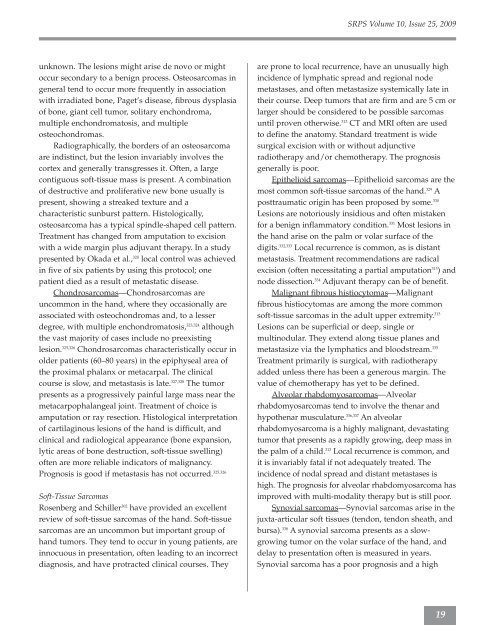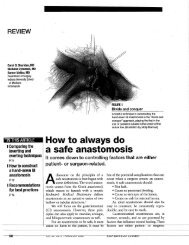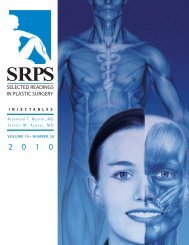SRPS PS - Plastic Surgery Internal
SRPS PS - Plastic Surgery Internal
SRPS PS - Plastic Surgery Internal
Create successful ePaper yourself
Turn your PDF publications into a flip-book with our unique Google optimized e-Paper software.
unknown. The lesions might arise de novo or might<br />
occur secondary to a benign process. Osteosarcomas in<br />
general tend to occur more frequently in association<br />
with irradiated bone, Paget’s disease, fibrous dysplasia<br />
of bone, giant cell tumor, solitary enchondroma,<br />
multiple enchondromatosis, and multiple<br />
osteochondromas.<br />
Radiographically, the borders of an osteosarcoma<br />
are indistinct, but the lesion invariably involves the<br />
cortex and generally transgresses it. Often, a large<br />
contiguous soft-tissue mass is present. A combination<br />
of destructive and proliferative new bone usually is<br />
present, showing a streaked texture and a<br />
characteristic sunburst pattern. Histologically,<br />
osteosarcoma has a typical spindle-shaped cell pattern.<br />
Treatment has changed from amputation to excision<br />
with a wide margin plus adjuvant therapy. In a study<br />
presented by Okada et al., 320 local control was achieved<br />
in five of six patients by using this protocol; one<br />
patient died as a result of metastatic disease.<br />
Chondrosarcomas—Chondrosarcomas are<br />
uncommon in the hand, where they occasionally are<br />
associated with osteochondromas and, to a lesser<br />
degree, with multiple enchondromatosis, 323,324 although<br />
the vast majority of cases include no preexisting<br />
lesion. 325,326 Chondrosarcomas characteristically occur in<br />
older patients (60–80 years) in the epiphyseal area of<br />
the proximal phalanx or metacarpal. The clinical<br />
course is slow, and metastasis is late. 327,328 The tumor<br />
presents as a progressively painful large mass near the<br />
metacarpophalangeal joint. Treatment of choice is<br />
amputation or ray resection. Histological interpretation<br />
of cartilaginous lesions of the hand is difficult, and<br />
clinical and radiological appearance (bone expansion,<br />
lytic areas of bone destruction, soft-tissue swelling)<br />
often are more reliable indicators of malignancy.<br />
Prognosis is good if metastasis has not occurred. 325,326<br />
Soft-Tissue Sarcomas<br />
Rosenberg and Schiller 302 have provided an excellent<br />
review of soft-tissue sarcomas of the hand. Soft-tissue<br />
sarcomas are an uncommon but important group of<br />
hand tumors. They tend to occur in young patients, are<br />
innocuous in presentation, often leading to an incorrect<br />
diagnosis, and have protracted clinical courses. They<br />
<strong>SR<strong>PS</strong></strong> Volume 10, Issue 25, 2009<br />
are prone to local recurrence, have an unusually high<br />
incidence of lymphatic spread and regional node<br />
metastases, and often metastasize systemically late in<br />
their course. Deep tumors that are firm and are 5 cm or<br />
larger should be considered to be possible sarcomas<br />
until proven otherwise. 313 CT and MRI often are used<br />
to define the anatomy. Standard treatment is wide<br />
surgical excision with or without adjunctive<br />
radiotherapy and/or chemotherapy. The prognosis<br />
generally is poor.<br />
Epithelioid sarcomas—Epithelioid sarcomas are the<br />
most common soft-tissue sarcomas of the hand. 329 A<br />
posttraumatic origin has been proposed by some. 330<br />
Lesions are notoriously insidious and often mistaken<br />
for a benign inflammatory condition. 331 Most lesions in<br />
the hand arise on the palm or volar surface of the<br />
digits. 332,333 Local recurrence is common, as is distant<br />
metastasis. Treatment recommendations are radical<br />
excision (often necessitating a partial amputation 313 ) and<br />
node dissection. 334 Adjuvant therapy can be of benefit.<br />
Malignant fibrous histiocytomas—Malignant<br />
fibrous histiocytomas are among the more common<br />
soft-tissue sarcomas in the adult upper extremity. 313<br />
Lesions can be superficial or deep, single or<br />
multinodular. They extend along tissue planes and<br />
metastasize via the lymphatics and bloodstream. 335<br />
Treatment primarily is surgical, with radiotherapy<br />
added unless there has been a generous margin. The<br />
value of chemotherapy has yet to be defined.<br />
Alveolar rhabdomyosarcomas—Alveolar<br />
rhabdomyosarcomas tend to involve the thenar and<br />
hypothenar musculature. 336,337 An alveolar<br />
rhabdomyosarcoma is a highly malignant, devastating<br />
tumor that presents as a rapidly growing, deep mass in<br />
the palm of a child. 313 Local recurrence is common, and<br />
it is invariably fatal if not adequately treated. The<br />
incidence of nodal spread and distant metastases is<br />
high. The prognosis for alveolar rhabdomyosarcoma has<br />
improved with multi-modality therapy but is still poor.<br />
Synovial sarcomas—Synovial sarcomas arise in the<br />
juxta-articular soft tissues (tendon, tendon sheath, and<br />
bursa). 338 A synovial sarcoma presents as a slowgrowing<br />
tumor on the volar surface of the hand, and<br />
delay to presentation often is measured in years.<br />
Synovial sarcoma has a poor prognosis and a high<br />
19






